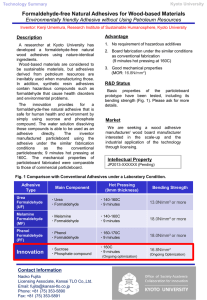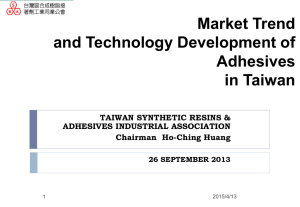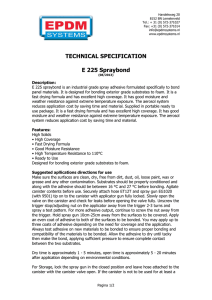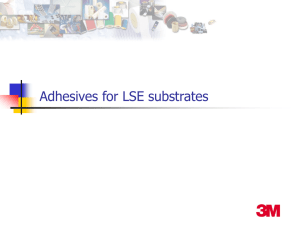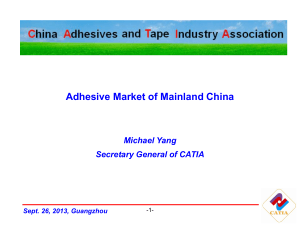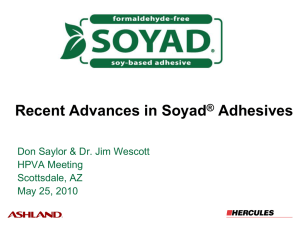15A NCAC 02D .0964 MISCELLANEOUS INDUSTRIAL
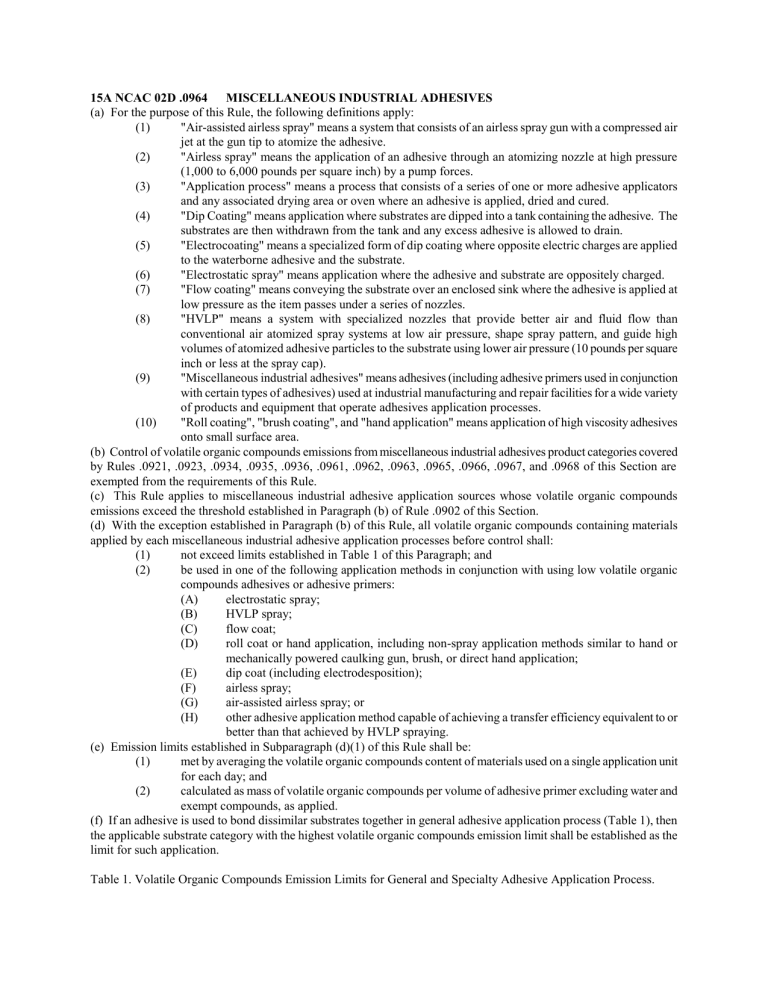
15A NCAC 02D .0964 MISCELLANEOUS INDUSTRIAL ADHESIVES
(a) For the purpose of this Rule, the following definitions apply:
(1) "Air-assisted airless spray" means a system that consists of an airless spray gun with a compressed air
(2) jet at the gun tip to atomize the adhesive.
"Airless spray" means the application of an adhesive through an atomizing nozzle at high pressure
(1,000 to 6,000 pounds per square inch) by a pump forces.
(3)
(4)
(5)
(6)
(7)
"Application process" means a process that consists of a series of one or more adhesive applicators and any associated drying area or oven where an adhesive is applied, dried and cured.
"Dip Coating" means application where substrates are dipped into a tank containing the adhesive. The substrates are then withdrawn from the tank and any excess adhesive is allowed to drain.
"Electrocoating" means a specialized form of dip coating where opposite electric charges are applied to the waterborne adhesive and the substrate.
"Electrostatic spray" means application where the adhesive and substrate are oppositely charged.
"Flow coating" means conveying the substrate over an enclosed sink where the adhesive is applied at
(8) low pressure as the item passes under a series of nozzles.
"HVLP" means a system with specialized nozzles that provide better air and fluid flow than conventional air atomized spray systems at low air pressure, shape spray pattern, and guide high volumes of atomized adhesive particles to the substrate using lower air pressure (10 pounds per square inch or less at the spray cap).
"Miscellaneous industrial adhesives" means adhesives (including adhesive primers used in conjunction (9) with certain types of adhesives) used at industrial manufacturing and repair facilities for a wide variety of products and equipment that operate adhesives application processes.
(10) "Roll coating", "brush coating", and "hand application" means application of high viscosity adhesives onto small surface area.
(b) Control of volatile organic compounds emissions from miscellaneous industrial adhesives product categories covered by Rules .0921, .0923, .0934, .0935, .0936, .0961, .0962, .0963, .0965, .0966, .0967, and .0968 of this Section are exempted from the requirements of this Rule.
(c) This Rule applies to miscellaneous industrial adhesive application sources whose volatile organic compounds emissions exceed the threshold established in Paragraph (b) of Rule .0902 of this Section.
(d) With the exception established in Paragraph (b) of this Rule, all volatile organic compounds containing materials applied by each miscellaneous industrial adhesive application processes before control shall:
(1)
(2) not exceed limits established in Table 1 of this Paragraph; and be used in one of the following application methods in conjunction with using low volatile organic compounds adhesives or adhesive primers:
(A)
(B)
(C)
(D) electrostatic spray;
HVLP spray; flow coat; roll coat or hand application, including non-spray application methods similar to hand or mechanically powered caulking gun, brush, or direct hand application;
(E)
(F)
(G)
(H) dip coat (including electrodesposition); airless spray; air-assisted airless spray; or other adhesive application method capable of achieving a transfer efficiency equivalent to or better than that achieved by HVLP spraying.
(e) Emission limits established in Subparagraph (d)(1) of this Rule shall be:
(1) met by averaging the volatile organic compounds content of materials used on a single application unit for each day; and
(2) calculated as mass of volatile organic compounds per volume of adhesive primer excluding water and exempt compounds, as applied.
(f) If an adhesive is used to bond dissimilar substrates together in general adhesive application process (Table 1), then the applicable substrate category with the highest volatile organic compounds emission limit shall be established as the limit for such application.
Table 1. Volatile Organic Compounds Emission Limits for General and Specialty Adhesive Application Process.
General Adhesive Application Processes
Reinforced Plastic Composite
Flexible vinyl
Metal
Porous Material (Except Wood)
Rubber
Wood
Other Substrates
VOC Emission Limit (lb/gal)
1.7
2.1
0.3
1
2.1
0.3
2.1
Specialty Adhesive Application Processes
Ceramic Tile Installation
Contact Adhesive
Cove Base Installation
VOC Emission Limit (lb/gal)
1.1
2.1
1.3
1.3
2.1
Floor Covering Installation (Indoor)
Floor Covering Installation (Outdoor)
Floor Covering Installation (Perimeter Bonded Sheet
Vinyl)
Metal to Urethane/Rubber Molding or Casting
Motor Vehicle Adhesive
Motor Vehicle Weatherstrip Adhesive
Multipurpose Construction
Plastic Solvent Welding (ABS)
5.5
7.1
2.1
6.3
1.7
Plastic Solvent Welding (Except ABS)
Sheet Rubber Lining Installation
Single-Ply Roof Membrane Installation/Repair (Except
EPDM)
Structural Glazing
3.3
4.2
7.1
2.1
Thin Metal Laminating
Tire Repair
Waterproof Resorcinol Glue
Adhesive Primer Application Processes
Motor Vehicle Glass Bonding Primer
0.8
6.5
0.8
1.4
VOC Emission Limit1 (lb/gal)
7.5
Plastic Solvent Welding Adhesive Primer
Single-Ply Roof Membrane Adhesive Primer
5.4
2.1
Other Adhesive Primer 2.1
(g) Any miscellaneous industrial adhesive application processes subject to this Rule, which chooses to use add-on control for adhesive application processes rather than to comply with the emission limits established in Paragraph (d) of this Rule, shall install control equipment with overall control efficiency of 85 percent or use a combination of adhesives and add-on control equipment on an application process to meet limits established in Paragraph (d) of this Rule.
(h) EPA Method 24 or 25A (40 CFR Part 60, Appendix A-7) shall be used to determine the volatile organic compounds content of adhesives, other than reactive adhesives, and the procedure established in Appendix A of the NESHAP for surface coating of plastic parts (40 CFR Part 63, Subpart PPPP) shall be used to determine the volatile organic compounds content of reactive adhesives unless the facility maintains records to document the volatile organic compounds content of adhesives from the manufacturer.
(i) The owner or operator of any facility subject to this Rule shall comply with the Rules .0903 and .0958 of this Section.
History Note: Authority G.S. 143-215.3(a)(1); 143-215.107(a)(5);
Eff. September 1, 2010.


